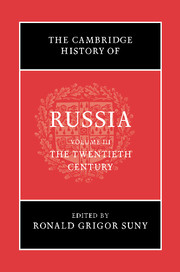Book contents
- Frontmatter
- Introduction
- 1 Reading Russia and the Soviet Union in the twentieth century: how the ‘West’ wrote its history of the USSR
- Part I Russia and the Soviet Union: The Story through Time
- Part II Russia and the Soviet Union: Themes and Trends
- 14 Economic and demographic change: Russia’s age of economic extremes
- 15 Transforming peasants in the twentieth century: dilemmas of Russian, Soviet and post-Soviet development
- 16 Workers and industrialization
- 17 Women and the state
- 18 Non-Russians in the Soviet Union and after
- 19 The western republics: Ukraine, Belarus, Moldova and the Baltics
- 20 Science, technology and modernity
- 21 Culture, 1900–1945
- 22 The politics of culture, 1945–2000
- 23 Comintern and Soviet foreign policy, 1919–1941
- 24 Moscow’s foreign policy, 1945–2000: identities, institutions and interests
- 25 The Soviet Union and the road to communism
- Bibliography
- Index
- References
16 - Workers and industrialization
from Part II - Russia and the Soviet Union: Themes and Trends
Published online by Cambridge University Press: 28 March 2008
- Frontmatter
- Introduction
- 1 Reading Russia and the Soviet Union in the twentieth century: how the ‘West’ wrote its history of the USSR
- Part I Russia and the Soviet Union: The Story through Time
- Part II Russia and the Soviet Union: Themes and Trends
- 14 Economic and demographic change: Russia’s age of economic extremes
- 15 Transforming peasants in the twentieth century: dilemmas of Russian, Soviet and post-Soviet development
- 16 Workers and industrialization
- 17 Women and the state
- 18 Non-Russians in the Soviet Union and after
- 19 The western republics: Ukraine, Belarus, Moldova and the Baltics
- 20 Science, technology and modernity
- 21 Culture, 1900–1945
- 22 The politics of culture, 1945–2000
- 23 Comintern and Soviet foreign policy, 1919–1941
- 24 Moscow’s foreign policy, 1945–2000: identities, institutions and interests
- 25 The Soviet Union and the road to communism
- Bibliography
- Index
- References
Summary
‘What is the contemporary factory worker in Russia’, asked Mikhail Tugan-Baranovskii towards the end of the nineteenth-century, ‘a peasant living on the land who makes up the deficiencies of his agricultural income by occasional factory work, or a proletarian bound closely to the factory who lives by selling his labour power?’ Tugan-Baranovskii, among Russia’s foremost political economists, seemed unsure how to answer the question. Citing earlier studies showing a decline in seasonal employment among workers in Moscow province, he nevertheless had to acknowledge that ‘the tie of the factory worker to the soil, although waning, is still very strong’, that it was ‘economically necessary and therefore is tenaciously maintained’. Yet, echoing an article of faith among Russian Marxists, he confidently predicted that ‘a complete severance of this tie … is inevitable, and the sooner it takes place the better’.
What was thus on one level an empirical question that lent itself to statistical enquiry into patterns of labour mobility, employment and workers’ ties to the land, on another implied more complex issues. Central to the Marxist paradigm of historical evolution, the formation of an industrial proletariat in Russia was a question that came to the fore during the 1890s because of the unprecedentedly rapid growth of factory industry, associated social dislocations and the political implications of these developments. Retrospectively, it served as the opening chapter in the revolutionary narrative that the Bolsheviks would tell about themselves and the society they were determined to transform.
Keywords
- Type
- Chapter
- Information
- The Cambridge History of Russia , pp. 440 - 467Publisher: Cambridge University PressPrint publication year: 2006
References
- 1
- Cited by



